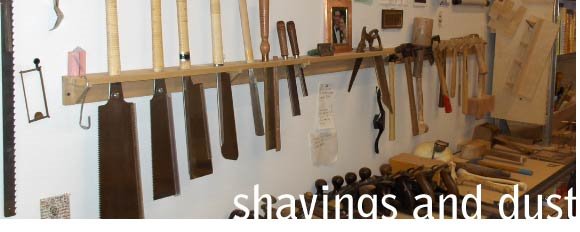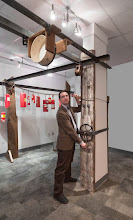I was approached by someone involved in that to take some of the big old beams that are coming out as part of the demolition process and turn them into benches that will ultimately be put in front of the building. It is a great idea, and a project I am excited to be a part of.
I spent Saturday in the shop with two students who were interested in being a part of this process. We had a great time, and for me it was relaxing (though tiring) to be in the shop for a solid day of moving wood around.
We spent a little time before they started designing looking at the old beams, reading as much

history as we could from them. We talked about what the mill building was when it was built and thought some about the people who built it. Though the wood was obviously mill-cut, the final shaping for installation was done with hatchets, in some places, which speaks of a time when carpenters had hatchets in their tool boxes.
When I cut off a sample chunk and resawed it on the band saw, the beautiful grain of the Douglas Fir was revealed, and we spent
some time smelling it and looking at it, and talking about fir and

where it comes from and how it grows and all of the things that were made from it. We looked at the difference between the hundred-year-old patina on the outside and the fresh golden color of the inside and talked about that contrast. Finally, after all of this, they started to design these benches.
 progress dry-fit of some of the parts:
progress dry-fit of some of the parts:The lines are clean, the material is simply presented and the history of the wood is honored. These students have different design styles from each other and from me, so this turn of events was unexpected. Which got me to thinking.
Is there something inherent in a reverence for history and an excitement about historical material that has a universal aesthetic? Could it be possible that, given an appropriate understanding of the provenance of the material, there are design choices that everyone would make?
This is a dangerous line of questioning, of course, implying that there is a pre-determined design path. But I can not help but wonder. I can not help but wonder if we all took the time to really get to know where we came from, to really look thoughtfully at all of the processes and chains of events that brought us to this moment, this Now, if we would not stand in more of an accord with regards to where we are going. If everyone all together made themselves aware of the history of our making, of the history of our building, of our governing, of our belief systems, if that would not help bring us together and unite us in a more thoughtful process as we figure out what kind of world we want to move through, and what kind of world we want our children to move through. I think it might help, at the very least.
So this is my assignment to everyone I meet up with today: Find one thing that is near you right now and really look at it. Think about how it came into your life, and then think about how it got to wherever you found it. How many trucks across country, how many miles on a container ship from Asia? What are the raw materials? Where did the petroleum for the plastic come from? Who got it out of the ground? Where did the tree that provided the wood (or the paper pulp) grow, and who cut it down? What kind of processing plant created it, and who works there? How do they work? What is their life like? What about the person who sold it to you? What is their life like? What is important to them? After thinking about all of this for a few minutes about one object, look at all of the objects in your house and realise that there is a similar thought process about all of them. Even gum wrappers. Even dish soap.
Boggles the mind.


1 comment:
Zeke, I've stumbled across your blog here and a lot of what you're saying are things I've thought about but never put to words. thanks
Andy Paquette
Post a Comment